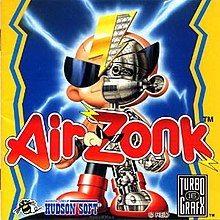Air Zonk, known in Japan as PC Denjin (PC原人シリーズ PC電人), is a horizontally scrolling shooter released for the TurboGrafx-16 in 1992. Air Zonk was an effort to update the company's image with a modern, punkish character named Zonk, who bears a deliberate resemblance to the TurboGrafx-16's caveman mascot, Bonk.
| Air Zonk | |
|---|---|
 US cover art | |
| Developer(s) | Red Company, Naxat Soft |
| Publisher(s) |
|
| Composer(s) | Daisuke Morishima Hisashi Matsushita |
| Platform(s) | TurboGrafx-16 |
| Release | |
| Genre(s) | Scrolling shooter |
| Mode(s) | Single-player |
The game was developed by Red Company, the original creators of the Bonk series, and also known for their Gate of Thunder series. Air Zonk features King Drool, the antagonist of the Bonk series, along with many other enemies from that series. A sequel, Super Air Zonk: Rockabilly-Paradise, was released in 1993 for the TurboDuo and has been made available on the Wii's Virtual Console.
Gameplay
editAir Zonk is a reimagining of the Bonk video game series as a scrolling shooter set in the future.[1] Artistically, the game is lighthearted, featuring humorous designs for the environment and characters.[2] Throughout the five levels,[1] the gameplay focuses on the effective use of shooting and bombing to complete each stage. At the start, the player may choose a companion character to team up with, such as an anthropomorphic gumball machine or a mummy with a drill attached to its head,[2] in order to enhance Bonk's powers.[3] Players can limit the use of designated companion characters for each level or opt not to use them at all. Each companion character, or friend, can only be used once. Air Zonk adopts the distinct visual style sometimes referred to as a "cute 'em up." There are three difficulty settings: sweet, spicy, and bitter.
Zonk can charge his shots, allowing him to fire a more powerful attack. A longer charge causes Zonk to drop a bomb, which damages all enemies on the screen. Zonk can also acquire seven types of power-ups, each of which can be charged for a unique special attack. As with most scrolling shooters, whenever Zonk acquires a new power-up, he loses the current one. If Zonk is hit while holding a power-up, he loses it but does not die, except in the case of the Mini-Zonk power-up. The Mini-Zonk power-up differs from other power-ups in that it cannot be charged and can be found in both florets and random enemy drops (while other power-ups can only be found in florets).
Zonk begins each stage alone and without power-ups. He must collect eight smiley faces, the eighth of which will appear in giant form with sunglasses, in order to summon his friend. Initially, the friend acts as a Gradius-style support, following Zonk and shooting projectiles. If the player collects another eight smiley faces, Zonk and his friend will merge into a hybrid form,[3] granting a new attack and 20 seconds of invulnerability. This new attack cannot be charged, and Zonk cannot drop bombs while in hybrid form. Once invincibility expires, if Zonk is hit, he will revert to his normal form, and his friend will leave. However, Zonk retains any power-up he had before transforming into hybrid form.
Reception
edit| Publication | Score |
|---|---|
| Eurogamer | 7/10[4] |
| GameSpot | 7.5/10[5] |
| IGN | 8/10[6] |
| Nintendo Life | 8/10[7] |
Air Zonk was awarded Best TurboGrafx Game of 1992 by Electronic Gaming Monthly.[8] The game has since gained a cult following. Many game critics consider Air Zonk to be one of the best games ever released for the TurboGrafx-16.
Legacy
editAir Zonk received a sequel in 1993 titled Super Air Zonk: Rockabilly-Paradise (also known as CD Denjin Rockabilly), which was released in the SuperCD format and requires the Super System Card to play on first-generation TurboGrafx-CD consoles. As its name suggests, the game features a CD audio soundtrack consisting of rockabilly music. The game includes all-new levels, assistants, and enemies.
Air Zonk was released on the Wii's Virtual Console in May 2007 in Japan, July in America, and on July 13 in Europe.[9][10][11] It was also released on the Wii U's Virtual Console in Japan on June 19, 2014, in America on July 27, 2017, and in Europe on August 3.[12][13][11]
References
edit- ^ a b Rodriguez, Steven (July 10, 2009). "Virtual Console Mondays: July 9, 2007". Nintendo World Report. Retrieved June 16, 2020.
- ^ a b Shive, Chris (February 23, 2020). "Pocket Power: Air Zonk". Hardcore Gamer. Retrieved June 16, 2020.
- ^ a b Tatlock, Lee (July 6, 2009). "Air Zonk". Retro Gamer. Retrieved June 16, 2020.
- ^ Whitehead, Dan (July 14, 2007). "Virtual Console Roundup". Eurogamer. Retrieved June 16, 2020.
- ^ Provo, Frank (July 24, 2007). "Air Zonk Review". GameSpot. Retrieved June 16, 2020.
- ^ Thomas, Lucas (July 18, 2007). "Air "Zonk" Review". IGN. Retrieved June 16, 2020.
- ^ Staff (July 9, 2007). "Air Zonk Review (TG-16)". Nintendo Life. Retrieved June 16, 2020.
- ^ "Electronic Gaming Monthly's Buyer's Guide". Electronic Gaming Monthly. 1993.
- ^ "Wii | Virtual Console バーチャルコンソール".
- ^ "Nintendo - Official Site - Video Game Consoles, Games - Nintendo - Official Site".
- ^ a b "Air Zonk".
- ^ "PC電人 | Wii U | 任天堂".
- ^ "Air Zonk for Wii U - Nintendo Game Details".
External links
edit- The Bonk Compendium (covering all games and references to Bonk and Air Zonk)
- Detailed information for Air Zonk at the PC Engine Software Bible
- Air Zonk featured in 1-up's "Stchick 'em up" article
- Information on Super Air Zonk